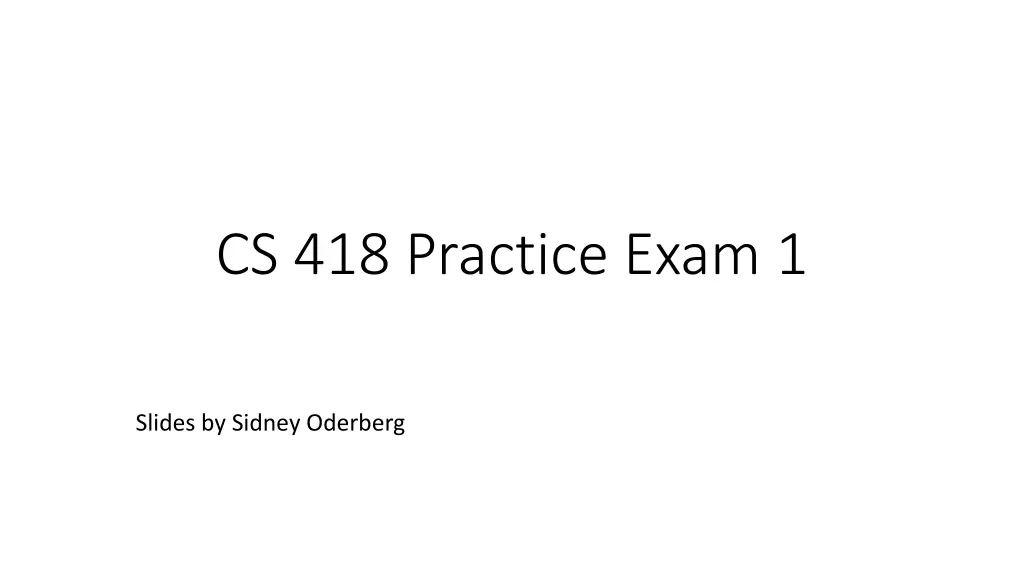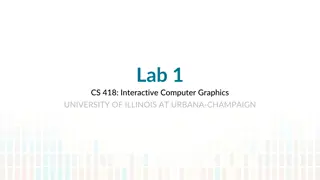
Exam Slides and Answers by Sidney Oderberg
Dive into the CS 418 practice exam slides prepared by Sidney Oderberg. Explore questions related to triangle fans, WebGL transformations, shader programming, and more with detailed answers provided for each question. Enhance your knowledge and understanding of computer graphics concepts through these engaging visuals.
Download Presentation

Please find below an Image/Link to download the presentation.
The content on the website is provided AS IS for your information and personal use only. It may not be sold, licensed, or shared on other websites without obtaining consent from the author. If you encounter any issues during the download, it is possible that the publisher has removed the file from their server.
You are allowed to download the files provided on this website for personal or commercial use, subject to the condition that they are used lawfully. All files are the property of their respective owners.
The content on the website is provided AS IS for your information and personal use only. It may not be sold, licensed, or shared on other websites without obtaining consent from the author.
E N D
Presentation Transcript
CS 418 Practice Exam 1 Slides by Sidney Oderberg
Answer Keep in mind that for triangle fans, each new vertex (beyond the first 2) creates a new triangle with the first vertex and the previous one. In this question, V6 is first and each of the four triangles share that vertex. V6, V5, and V4 make the first triangle (in the bottom right), V6, V4, and V3 make the second one, and so on.
Answer The first three vertices make one triangle. Then each vertex after that makes another new triangle. So only the first two vertices did not result in a new triangle, hence we get N-2 triangles for N vertices. The same applies to triangle fans.
Answer There needs to be a translation because in WebGL the origin (0,0) is in the center of the canvas (window coordinates), but the origin in the viewport coordinates is at the bottom left pixel. Then there needs to be a scale transformation to fit the resolution of the screen. There is no need for a rotation because the window and viewport coordinates are axis-aligned.
Answer It s not (b) because that s what varyings do. It s not (c) because that describes attributes. (d) is wrong because uniforms do not need to be matrices and they can be passed to the fragment shader. This leaves (a), which is right because uniforms are initialized by the application (Javascript) and can be passed to either the fragment shader or the vertex shader.
Answer Recall the formation of y-axis rotations from lecture (left). It s important to remember that the negative on the sin is on the bottom left sin, whereas for x and z rotations it s on the top right sin. Plugging 90 degrees in for theta will yield the correct answer.
Answer What you ve got to know for this one is that the matrices are applied to the vertex from right to left. So first the modelMatrix is multiplied with the vertex, and then the viewMatrix, and then the orthoMatrix. Also necessary for this question is an understanding of the vertex pipeline. The left image shows the model transform happening first, then viewing, and then perspective, which matches the correct answer (orthographic is a perspective transformation).
Answer For questions like these, you can try options until one matches the right answer. First you can eliminate some options. The resulting transformation has values on the diagonal and in the rightmost column only, so this can be a hint that you ll need to translate and scale. Notice that two of the options have the same transformations, but multiplied in different orders. The order does matter here, and if you do S(10,5) * T(0,10) you ll end up scaling the translation. The multiplication in (a) ends up with the right matrix.

